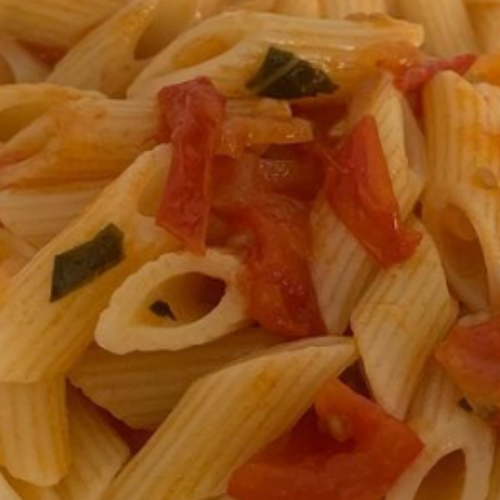Method:
Prepare the Pasta:
Bring a large pot of salted water to a boil over medium-high heat. Add the pasta and cook it according to the package instructions (usually about 8-10 minutes for al dente).
Once cooked, drain the pasta, reserving a cup of pasta water for later.
Make the Sauce:
While the pasta is cooking, heat the olive oil in a large skillet over medium heat. Add the garlic and sauté it until fragrant, about 1 minute be careful not to burn it!
Add the canned tomatoes (with juice) to the pan. Crush the tomatoes with a wooden spoon to break them apart into chunks.
Stir in salt and pepper to taste. Allow the sauce to simmer for 10 minutes, stirring occasionally. The tomatoes will soften, and the flavors will meld together.
Combine Pasta and Sauce:
Once the sauce is ready, add a small amount of the reserved pasta water to the sauce to thin it out a little (about 1/4 cup). You can adjust this based on your desired sauce consistency.
Add the drained pasta to the skillet with the sauce. Toss the pasta in the sauce for 2-3 minutes, ensuring the pasta is fully coated with the sauce.
Add Fresh Basil:
Tear fresh basil leaves and add them directly to the pasta, stirring them in so their flavor infuses the sauce. This will bring a fresh, herbal note to the dish.
Serve:
Plate the pasta and top with grated Parmesan, if desired. The cheese adds a creamy finish, but it’s optional if you want a dairy-free version.
Variations:
Gluten-Free: Use gluten-free pasta made from rice, corn, or quinoa.
Vegan: Skip the Parmesan cheese for a dairy-free version. You could also try a vegan Parmesan alternative.
Spicy: Add a pinch of red pepper flakes to the sauce for a spicy kick.
Extra Vegetables: Add finely chopped zucchini or bell peppers to the sauce for an extra burst of color and nutrition.
